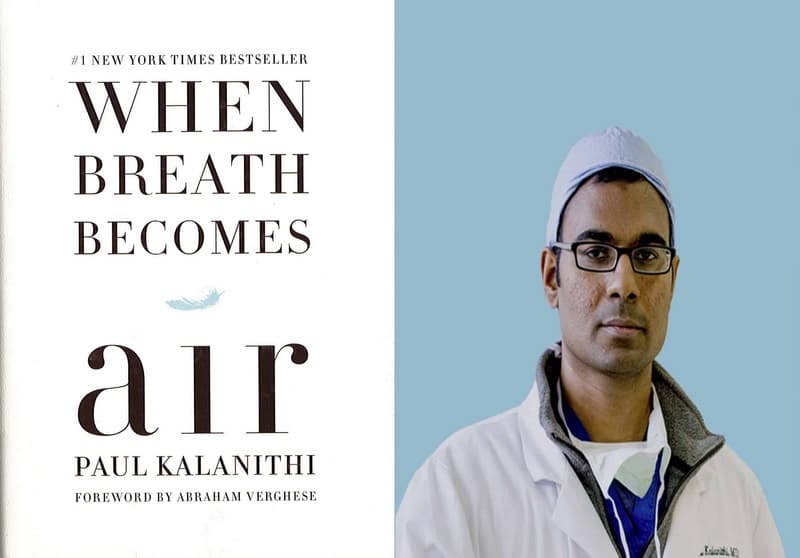Sentence-Summary: When Breath Becomes Air helps you see what’s really important by diving into Paul Kalanithi’s life of loving neuroscience, literature, meaning, and his family that ended from cancer in his mid-thirties.
خلاصه کتاب وقتی نفس هوا میشود در یک جمله: کتاب وقتی نفس هوا میشود: کتاب وقتی هوا نفس میشود: When Breath Becomes Air به شما کمک میکند تا با جهش در زندگی پل کالانیتی عشق او به علوم اعصاب، ادبیات، معنا و خانوادهاش که در اواسط سی سالگی به دلیل سرطان به پایان رسید، ببینید چه چیزی واقعا اهمیت دارد.
Favorite quote from the author:
Life is short. But we go about most days not thinking about our inevitable death. It might not be a pleasant thing to dwell on, but maybe if we did we would try to live more meaningful lives. Maybe we would spend less time working and more time with family or helping others. Maybe we would leave some sort of wisdom for those who come after us.
نقل قولی از نویسنده:
زندگی کوتاه است. اما ما اکثر روزها را با فکر کردن به مرگ اجتناب ناپذیر خود نمیگذرانیم. شاید انجام آن چندان خوشایند نباشد، اما شاید اگر این کار را میکردیم، سعی میکردیم تا زندگی معنادارتری داشته باشیم. شاید زمان کمتری برای کار و زمان بیشتری با خانواده یا کمک به دیگران صرف میکردیم. شاید برای کسانی که بعد از ما میآیند نوعی خرد و حکمت باقی بگذاریم.
When neurosurgeon Paul Kalanithi got the news that he was going to die of cancer in his mid-thirties, he wanted to make sure he left his piece of wisdom in writing. Writing to a friend about his diagnosis he said, “The good news is that I’ve already outlived two Brontës, Keats and Stephen Crane. The bad news is that I haven’t written anything.”
زمانی که به پل کالانیتی جراح مغز و اعصاب خبر رسید که در اواسط دهه 30 از زندگیاش بر اثر سرطان میمیرد، میخواست از این موضوع مطمئن شود که دانش خود را به صورت مکتوب به جا گذاشته باشد. او در نوشتن برای یکی از دوستانش در مورد تشخیص خود گفت: «خبر خوب این است که من از دو برونته، کیتس و استفن کرین بیشتر زندگی کردهام. خبر بد این است که من چیزی ننوشتم.»
Writing it wouldn’t be easy because of his fragile and worsening health. In When Breath Becomes Air, Kalanithi shares his feelings on being diagnosed with terminal cancer at the peak of his life and career with so much potential in front of him.
به دلیل شکننده بودن و بدتر شدن وضعیت سلامتیاش نوشتن دانش خود کار آسانی خواهد بود. در کتاب وقتی نفس هوا میشود، کالانیتی احساسات خود را در مورد تشخیص سرطان ترمینال در اوج زندگی و حرفهاش با وجود پتانسیلهای فراوانی که در پیش داشت، به اشتراک میگذارد.
Here are the 3 most interesting things I learned about this man’s life:
Kalanithi was passionate about neuroscience and literature.
A career in the medical field proved difficult and taught him much about the intricacies of life and death right from the start.
Terminal cancer made Kanaithi’s think a lot about his career, life, and the future of his family.
Let’s see what we can learn from the life and philosophy of this amazing man!
در اینجا 3 تا از جالبترین چیزهایی که در مورد زندگی این مرد یاد گرفتم را مرور میکنیم:
کالانیتی علاقه زیادی به علوم اعصاب و ادبیات داشت.
دشوار بودن کار در رشته پزشکی از همان ابتدا به او چیزهای زیادی در مورد پیچیدگیهای زندگی و مرگ آموخت.
سرطان ترمینال باعث شد کنایتی درباره حرفه، زندگی و آینده خانوادهاش فکر کند.
Lesson 1: Neuroscience and writing were Kalanithi’s two passions.
درس 1: علوم اعصاب و نوشتن دو علایق کالانیتی بودند.
Growing up, Paul Kalanithi fell in love with literature. He decided he would study literature, but in the summer before college, he found something else captivated him: human biology. On his way to Stanford, he got a book that explored the idea that the brain is a machine that allows the human mind to exist. His fascination led to him taking neuroscience courses.
پل کالانیتی با بزرگ شدنش، عاشق ادبیات شد. او تصمیم گرفت تا ادبیات بخواند، اما در تابستان قبل از کالج، متوجه شد که چیز دیگری او را مجذوب خود کرده است: زیست شناسی انسان. در راه خود به استنفورد، کتابی دریافت کرد که این ایده را که مغز ماشینی است که به ذهن انسان اجازه میدهد وجود داشته باشد، بررسی میکرد. شیفتگی او باعث شد تا دورههای علوم اعصاب را بگذراند.
Kalanithi liked to ponder big questions like what life’s meaning was, and looked to both neuroscience and literature to find answers. He felt literature, and particularly fiction, was a manifestation of the mind’s life. He drew from works that connected meaninglessness and isolation, concluding that true meaning comes from human relationships.
کالانیتی دوست داشت به پرسشهای بزرگی بیندیشد، مانند این که معنای زندگی چیست و برای یافتن پاسخ خود به علوم اعصاب و ادبیات نگاه میکرد. او احساس میکرد ادبیات و به ویژه داستان، تجلی زندگی ذهن است. او از آثاری که بیمعنایی و انزوا را به هم مرتبط کرده و به این نتیجه رسیده بودند که معنای واقعی زندگی از روابط انسانی ناشی میشود، این موضوع را برداشت کرده بود.
But he understood that literature wouldn’t give him the whole answer. He needed to keep studying neuroscience to understand human meaning. Kalanithi believed that because the brain allows our mind to exist, the ability we have to build relationships comes directly from the brain. He also knew if he wanted to understand life, he needed to understand the most unavoidable part of it all: death. What better way to do this than practice medicine?
اما فهمید که ادبیات جواب کامل را به او نمیدهد. او برای درک معنای انسان باید به مطالعه علوم اعصاب ادامه دهد. کاتالینی معتقد بود که چون مغز به ذهن ما اجازه میدهد وجود داشته باشد، توانایی ما برای ایجاد روابط مستقیما از مغز میآید. او همچنین میدانست که اگر میخواهد زندگی را بفهمد، باید اجتنابناپذیرترین بخش آن را درک کند: مرگ. چه راهی بهتر از طبابت برای این کار؟
Lesson 2: He learned much about life and death during his time in medical school and later as a doctor.
درس 2: او در دوران تحصیل در دانشکده پزشکی و بعدها به عنوان پزشک، چیزهای زیادی در مورد زندگی و مرگ آموخت.
During his time in medical school, Kalanithi spent a lot of time with cadavers. Most students covered the faces of the cadavers and didn’t learn their names, but he was moved by their humanity.
در دوران تحصیل در دانشکده پزشکی، کالانیتی زمان زیادی را با اجساد سپری کرد. اکثر دانشجویان صورت اجساد را پوشانده بودند و نام آنها را یاد نمیگرفتند، اما او تحت تاثیر انسانیت آنها قرار گرفت.
His first experience with a birth was also about death. A woman went into premature labor and lost both of her twins. Because of this experience, Kalanithi was left with the image of life one day, death the next.
اولین تجربه او از تولد نیز در مورد مرگ بود. زنی دچار زایمان زودرس شد و هر دو دوقلو خود را از دست داد. به خاطر این تجربه، تصویر زندگی در یک روز و مرگ در روز دیگر، برای کالانیتی باقی ماند.
When he specialized in neurosurgery, he realized how much responsibility he would have in life or death decisions. He struggled with the expectation to be able to judge who could be saved, who couldn’t, and who shouldn’t be saved. If he rushed a patient to the OR to save their life but they were left to live unable to speak and eat, was this really the life they wanted?
زمانی که او در زمینه جراحی مغز و اعصاب تخصص یافت، متوجه شد که چقدر در تصمیمات زندگی یا مرگ [بیماران] مسئولیت دارد. او با این انتظار دست و پنجه نرم میکرد که بتواند قضاوت کند چه کسی میتواند نجات یابد، چه کسی نمیتواند و چه کسی نباید نجات یابد. اگر او یک بیمار را با عجله برای نجات جانشان به OR ببرد، اما بدون این که بتوانند صحبت کنند و غذا بخورند، رها شوند، آیا واقعاً این همان زندگیای بود که آنها میخواستند؟
He witnessed many deaths, both from patients and even people who worked at the hospital. When he got deeper into his practice, he tells of his regrets that his exhaustion and stress from his responsibility sometimes made him neglect his patients’ humanity.
او شاهد مرگ و میرهای بسیاری بود، چه از جانب بیماران و چه حتی افرادی که در بیمارستان کار میکردند. وقتی عمیقتر به کارش میپردازد، از پشیمانی هنگامی میگوید که خستگی و استرس ناشی از مسئولیتش گاهی باعث میشود انسانیت بیمارانش را نادیده بگیرد.
Lesson 3: Kalanithi’s life ended in his mid-thirties from cancer, but his reflections on the illness can teach us much about life.
درس 3: زندگی کالانیتی در اواسط سی سالگیاش به دلیل سرطان به پایان رسید، اما تاملات او در مورد بیماری میتواند چیزهای زیادی در مورد زندگی به ما بیاموزد.
By the time his residency was ending, he had earned awards and the respect of senior doctors. He even had a great job lined up. But after months of back pain, he found out that he had malignant lung cancer that was spreading across his body.
زمانی که دوره رزیدنتی او داشت به پایان میرسید، جوایز و احترام پزشکان ارشد را به دست آورده بود. او حتی کار بزرگی و هماهنگ شده هم داشت. اما پس از ماهها کمردرد، متوجه شد که سرطان بدخیم ریه دارد که در سراسر بدنش پخش شده است.
Following the terrible news, he contemplated what to do. He talked with his doctor about how disturbing it felt not to know how long he had left. If he had many years, he wanted to continue his practice. If he had only a couple, he wanted to be with his family and write. His doctor advised him to do what really mattered.
به دنبال این خبر وحشتناک، او به این فکر کرد که چه کاری باید انجام دهد. با پزشکش درباره این صحبت کرد که چقدر ناراحت کننده است که نمیداند چقدر از زمانش مانده. اگر سالهای زیادی وقت داشت، میخواست به کار خود ادامه دهد. اگر فقط یکی دو ماه وقت داشت، میخواست در کنار خانواده باشد و بنویسد. دکترش به او توصیه کرد که کاری را که واقعا برایش مهم است انجام دهد.
He also had a hard time being both doctor and patient. As a doctor, he was a force of action. But as a patient, things happened to him. He gained empathy for patients with chronic and terminal illness that he wouldn’t be able to understand by any other way.
او برای این که هم پزشک و هم بیمار بودن زمان سختی را گذراند. او به عنوان یک پزشک نیروی عمل بود. اما به عنوان یک بیمار، اتفاقاتی برایش افتاد. او با بیماران مبتلا به بیماری مزمن و لاعلاج احساس همدلی کرد که به هیچ وجه از راه دیگری قادر به درک آنها نبود.
He and his wife decided after much deliberation they would have the child they always wanted. Lucy gave birth to a daughter Cady, and Kalanithi was able to be there for the birth though he was weak. He ends the book with a message to Cady, saying she has given him the greatest joy of his life.
او و همسرش پس از مشورت زیاد تصمیم گرفتند فرزندی را که همیشه میخواستند داشته باشند. لوسی دختری به دنیا آورد به اسم کادی. کالانیتی هم با این که ضعیف بود، توانست برای زایمان حضور داشته باشد. او کتاب را با پیامی به کادی پایان میدهد و میگوید که او بزرگترین لذت زندگیاش را به او بخشیده است.
In the last months of his life, he focused on being with family. He and Lucy grew closer at this time and spent time with friends and playing with baby Cady. He lived what life he had in the best way he could, saying, “Even if I’m dying, until I actually die, I’m still living.”
او در ماههای آخر زندگیاش روی حضور در کنار خانواده تمرکز داشت. او و لوسی در این زمان بیشتر به هم نزدیک شدند و وقت خود را با دوستان و بازی با کادی کوچولو گذراندند. او اندک زمانی که داشت را به بهترین شکل زندگی کرد و گفت: «حتی اگر در حال مرگ باشم، تا زمانی که واقعا بمیرم، هنوز زندهام.»
Eventually, he became too weak to finish the book. Lucy wrote the epilogue, describing him facing death with integrity. It’s unfinished, but perhaps that’s what makes this book about confronting the uncertainty of death most realistic. But we are thankful to Dr. Kalanithi for sharing such beautiful thoughts about what gives life meaning.
در نهایت او ضعیفتر از آن شد که کتاب را به پایان برساند. لوسی بخش آخر کتاب را نوشت و او را در مواجهه با مرگ با صداقت توصیف کرد. کتاب ناتمام است، اما شاید این همان چیزی است که این کتاب را در مورد رویارویی با عدم قطعیت مرگ واقعیتر میکند. اما ما از دکتر کالانیتی برای به اشتراک گذاشتن چنین افکار زیبایی در مورد آنچه به زندگی معنا میبخشد، سپاسگزاریم.
When Breath Becomes Air Summary Review
When Breath Becomes Air is both inspiring and tragic at the same time. It was fascinating to hear about death from the perspective of both a doctor and a patient. This book will help you understand what is truly important in life and helps you confront the inevitability of death.
مرور کتاب وقتی نفس هوا میشد
کتاب وقتی نفس هوا میشود هم الهامبخش و هم از طرفی غمانگیز است. شنیدن درباره مرگ از منظر یک پزشک بیمار بسیار جذاب بود. این کتاب به شما کمک میکند بفهمید چه چیزی واقعا در زندگی مهم است و به شما کمک میکند با مرگ اجتنابناپذیر خود مقابله کنید.






